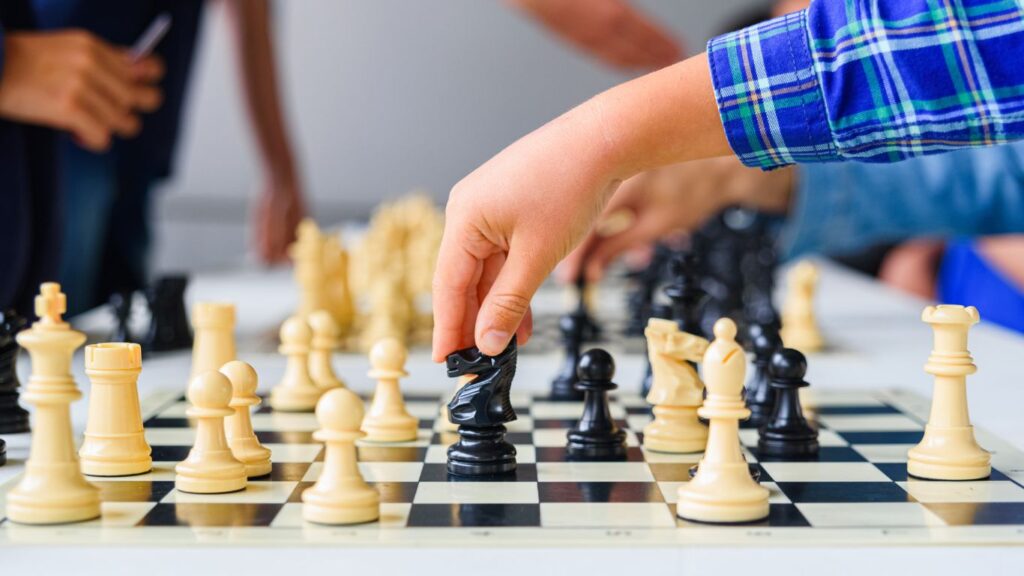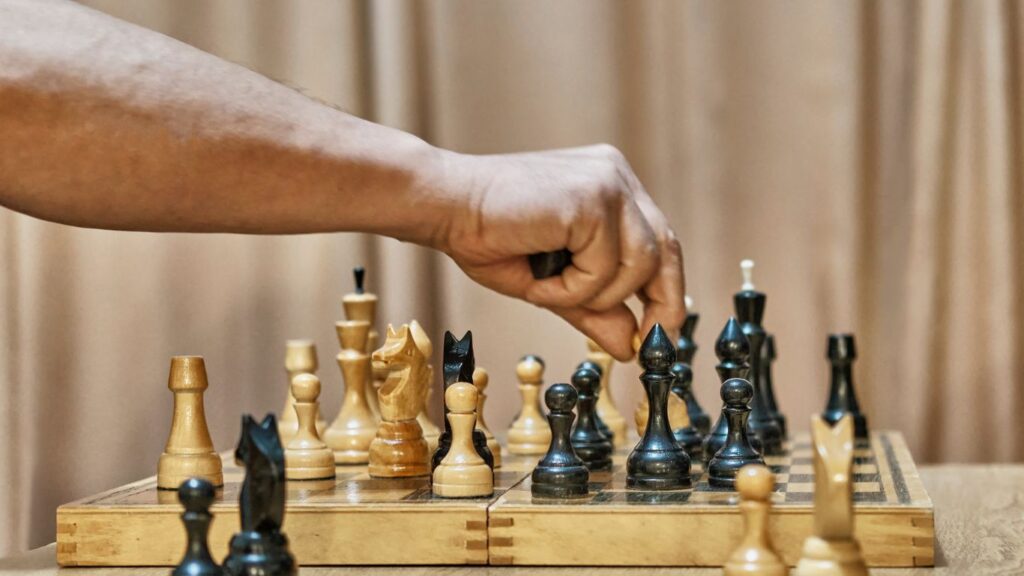Chess is a timeless board game that combines strategy, tactics, and a bit of creative thinking. Loved by millions worldwide, it’s a game that can be learned relatively quickly but can take a lifetime to master. This guide aims to introduce you to the fundamentals of chess, helping you understand the board, the pieces, and the rules that make chess such a profound and enjoyable game.
Introduction
Chess is not just a game; it is an intellectual odyssey that involves two players, each commanding an army with the ultimate goal to outmanoeuvre and outwit the opponent. It’s a game that can sharpen your decision-making skills, improve your concentration, and enhance your problem-solving abilities.

Credit amazon.com
Understanding the Chessboard
The chessboard consists of 64 squares in an 8×8 grid. Each square is identified by a unique coordinate that corresponds to its column (a) and row (1-8). At the beginning of a game, the pieces are arranged on the two rows nearest to each player, with the white pieces typically moving first.
Initial Setup of Pieces on the Board
The pieces are set up symmetrically, with pawns occupying the front rows (rank two and rank 7), and behind them, the other pieces are arranged as follows:
- Rooks in the corners.
- Knights next to the rooks.
- Bishops beside each knight.
- The queen on the remaining square of her colour (white queen on the white, black queen on black).
- The king occupies the last square beside the queen.
Movement of Chess Pieces
Every piece moves differently, and understanding their movements is crucial:
- Pawn: Moves forward one square but captures diagonally. On its first move, a pawn can move forward two squares.
- Bishop: Moves diagonally across the board for any number of squares.
- Knight: Moves in an ‘L’ shape pattern – two squares in one direction and then one more square at a 90-degree angle.
- Rook: Moves horizontally or vertically across the board for any number of squares.
- Queen: Moves horizontally, vertically, or diagonally for any number of squares.
- King: Can move one square in any direction.

Credit chess.com
The objective of the Game
The primary objective is to place the opponent’s king under direct threat of capture (check) in such a way that there is no move to remove that threat (checkmate).
Special Moves and Rules
- Castling: A move where the king and one of the rooks are moved simultaneously for king safety and rook activation, with certain conditions.
- En Passant is a special pawn capture that can only occur immediately after a pawn moves two squares forward from its starting position. An enemy pawn could have captured it if it had moved only one square forward.
- Pawn Promotion: When a pawn reaches the far end of the board (the eighth rank), it is promoted and must be exchanged for a queen, rook, bishop, or knight of the same colour.

Credit amazon.com
Basic Strategies
Players should aim to control the centre of the board with their pieces, develop their pieces (move them out from their starting positions) efficiently, and safeguard their king typically by ‘castling’.
Tips for Strategy and Tactics
Understanding basic principles such as controlling the centre, keeping your king safe, and being aware of the entire board can significantly improve your gameplay. Always try to anticipate your opponent’s moves and plan your strategy accordingly.
Etiquette in Chess
Chess etiquette is essential, especially in tournament play. Always shake hands before and after a game, avoid talking or distractions while a game is in session, and make it a habit to record your moves in notation form during serious play.

Credit ebay.com
FAQs
Q: Is it necessary to memorize chess openings to be good at chess?
A: While memorizing chess openings can give you an early advantage by putting your pieces in favourable positions from the start, it’s optional to be good at chess. Understanding the principles behind the openings can be more beneficial than memorizing them.
Q: Can I play chess if I don’t have a physical board?
A: Yes, there are numerous online platforms and apps where you can play chess against opponents from around the world or even against computer opponents. These digital options can also help you learn and improve your Game.
Q: How long does it take to become proficient at chess?
A: The timeline for becoming proficient at chess varies from person to person, depending on how much time you invest in learning and practising the Game. Some players see significant improvement within a few months, while for others, it may take longer to grasp the nuances of advanced play.
Q: Are there any age restrictions for playing chess?
A: Chess is a game for all ages. Children can start learning chess as early as five or six years old, and there is no upper age limit for playing. In fact, playing chess can be a beneficial mental exercise at any age.
Q: How do I know if I am ready to enter a chess tournament?
A: If you understand the basic rules, can play through a complete game without making any major rule violations, and are willing to challenge yourself, then you are ready to consider entering a tournament. It’s a great way to gauge your progress, meet other chess enthusiasts, and learn from both victories and defeats.
Conclusion
Remember, understanding chess basics is just the beginning. Practice is vital, as are patience and studying the Game. Chess offers endless possibilities and discoveries, so keep playing and enjoy the ride on your way to becoming a skilled chess player. Happy gaming!
Additional Resources
- Chess.com: An online platform for playing chess, learning strategies, and connecting with other players.
- Chess Openings Explorer by 365Chess: A comprehensive database of chess openings for studying and analyzing different variations.
- The Queen’s Gambit (Netflix series): A popular mini-series that showcases the world of competitive chess in a unique and captivating way.
- Chess Books: There are plenty of books on chess, covering everything from beginner’s guides to advanced strategies. Some notable titles include “Bobby Fischer Teaches Chess” by Bobby Fischer, “Chess Fundamentals” by José Raúl Capablanca, and “My System” by Aron Nimzowitsch. So, keep reading and learning to improve your chess game! # Beginner’s Guide to Playing Chess
Chess is a timeless board game that combines strategy, tactics, and a bit of creative thinking. Loved by millions worldwide, it’s a game that can be learned relatively quickly but can take a lifetime to master. This guide aims to introduce you to the fundamentals of chess, helping you understand the board, the pieces, and the rules that make chess such a profound and enjoyable game.









